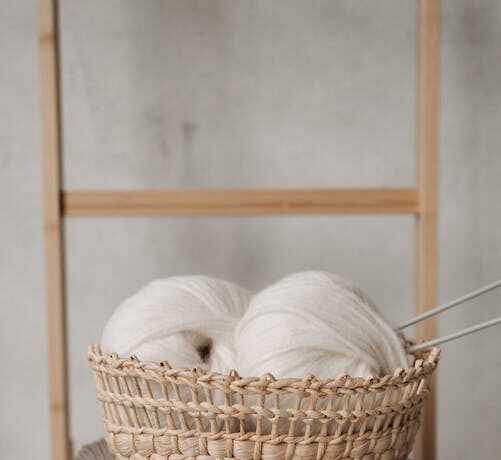If you are a beginner to spinning yarn, there are some tools you can start with. There is something beautiful about using hand spun yarn and it allows you greater flexibility when it comes to creative freedom.
There are tools that will help after you have spun your yarn. One such tool is the skein winder which allows you to hand wind the yarn into a skein. There are different sizes of this and you will be able to count the yardage and have it prepared to wash. A set of hand wool carders can be used to prepare raw or washed fibres for spinning. Carding can also prepare the fibres for felting and also blending various fibres together. A larger version of the hand carders is blending boards. They carry out the same function but have a large surface area.

Drum carders can prepare the fibres faster than a hand carder but they tend to be more expensive. You can use a control card to check the diameter of the yarn you are spinning to get an idea of how far along you are in the project and the level of consistency. A skein of yarn can be held up by a ball winder and a yarn swift. You will also need to weigh the yarn when carrying out larger projects so a weighing scale is a useful tool. To keep your spindles in one place when you ply yarn, you can use a lazy Kate.
One of the main tools for spinning yarn is the spinning wheel. You can find them in so many sizes and shapes. There are also different tension techniques so you have to select a model based on your requirements. It is best to carry out a lot of research before purchasing a spinning wheel. Experienced spinners will also be helpful in guiding you towards a spinning wheel that fulfils your requirements.
It is best to try out a few wheels before you purchase so you understand which suits you better. You can also build a spinning wheel on your own which can be an interesting project on its own. There are student spindles you can purchase at any craft store. So it is possible to start your spinning journey on a small budget. If you have some money to spare, there are handcrafted spindles that spin well and have a good balance.

It can feel a little intimidating to start your spinning journey but all you have to do is focus on the basics. You can start with a spinner wheel, e-spinner or a drop spindle. Consider your budget and availability of the spinning wheel when selecting a model. There are also different fibres that you can start with.
The most common fibre you can start with is wool but you can also choose to go with fibres like cotton and flax. You can read about different breeds of sheep and the different characteristics of their wool. If you are a beginner, you can start with a medium wood such as Cheviot or Corriedale which are quite soft and will draft easily.
what are tool we need for spinning yarn
There are a few different types of spinning tools that can be used to create yarn, including: – Spinning wheels – Drop spindles – Hand cards and combs – Yarn swift and ball winder Each type of tool has its own advantages and disadvantages, so it’s important to choose the right one for your needs. In this blog post, we’ll take a closer look at each of these options and help you decide which is best for you.
What is spinning yarn?
There are a few things you need in order to start spinning yarn:
-A spinning wheel (or a drop spindle if you’re just getting started)
-Fiber (wool, cotton, silk, flax, etc)
-A distaff (if you’re using wool)
-Yarn or roving (prepared fibers)
That’s really all you need to get started! Of course, there are other things that can make your spinning easier or more enjoyable, but they’re not necessary.
The different types of yarn
There are many different types of yarn, each with its own set of properties. The type of yarn you choose will depend on the project you’re working on and the desired results.
The most common types of yarn are:
Wool – Wool is a warm, durable fiber that’s ideal for winter garments. It can be scratchy, so it’s often blended with other fibers to soften it.
Cotton – Cotton is a cool, absorbent fiber that’s perfect for summer garments or projects that will be washed frequently. It can be less durable than other fibers, so it’s often combined with stronger fibers like wool or acrylic.
Acrylic – Acrylic is a synthetic fiber that’s inexpensive and easy to care for. It’s often used in projects where durability is more important than softness, such as blankets or hats.
Blends – Blends are created when two or more different fibers are combined. This can create a yarn with unique properties, such as increased durability or warmth.
The tools you need to spin yarn
There are a few different ways to spin yarn, and the tools you need will depend on the method you choose. If you want to hand-spin yarn, you’ll need a spinning wheel or a drop spindle. A spinning wheel is the more traditional option, and it can be used to create a wide variety of yarns. A drop spindle is simpler and easier to learn how to use, making it a good option for beginners.
If you want to machine-spin yarn, you’ll need a knitting machine or a crochet machine. These machines are electrically powered and can quickly produce large quantities of yarn. However, they can be expensive to purchase and require some experience to operate.
No matter which method you choose, you’ll also need some source of fiber that you can spin into yarn. This can be anything from wool roving to cotton thread. Once you have your tools and materials, you’re ready to start spinning yarn!
The benefits of spinning yarn
There are many benefits to spinning your own yarn. It is a meditative and calming activity that can be very therapeutic. It is also a great way to save money, as hand-spun yarn is often less expensive than store-bought yarn. Additionally, spinning your own yarn allows you to create unique and one-of-a-kind skeins that you can use in your knitting or crocheting projects.
You Might Also Like
How to Choose the Perfect Hair Topper for Your Needs?
You will be able to have added coverage, volume and boost your confidence when you choose the perfect hair topper....
Shedding Light on Skylights: Enhancing Spaces with Natural Illumination
Skylights are incredibly adaptable and transforming elements that have many uses beyond aesthetics in the fields of architectural design and...
The Impact of Office Chairs on Posture and Health
Office chairs are essential when it comes to the modern work environment. So many people are spending up to eight...
Examining the Various Nursing Education Paths: Which Course Is Best for You?
Do you have a strong desire to improve people's lives and advance healthcare? If so, you might be a great...









